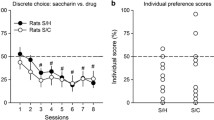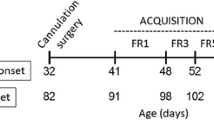Abstract
Rationale
Rats selectively bred for high saccharin (HiS) intake consume more alcohol and acquire intravenous (i.v.) cocaine self-administration more rapidly than their low saccharin (LoS)-consuming counterparts. The present experiment was designed to determine whether HiS and LoS rats differed in other aspects of drug abuse.
Objective
The purpose of the present experiment was to use a two-lever dose self-selection procedure to investigate the regulation/dysregulation of i.v. cocaine self-administration in female HiS and LoS rats.
Materials and methods
HiS and LoS rats were trained to self-administer eight different doses of cocaine during daily 5-h sessions, with the cocaine doses ranging from 0.2 to 1.6 mg/kg in steps of 0.2 mg/kg. The dose size increased after a response on one lever (infusion duration lengthened by 3 s) and decreased after a response on the other lever (infusion duration shortened by 3 s), with a lower limit of 0 s and with an upper limit of 24 s (a corresponding range of 0 to 1.6 mg/kg); the animals increased or decreased their self-administered dose in nine discrete steps.
Results
The HiS rats showed less precise regulation of their postinfusion interval (PII) than LoS rats based on the size of the previously self-administered cocaine dose. Correlations between these variables were lower for HiS than for LoS rats during the acquisition and maintenance phases, and HiS rats had lower PIIs than LoS rats after many of the cocaine doses. The HiS rats also self-administered significantly more cocaine infusions during the maintenance phase than the LoS rats, especially at the highest dose.
Conclusions
These data indicate that HiS rats are more likely to self-administer more cocaine infusions, at higher doses, and with less precise dose-time regulation than LoS rats. Thus, rats selectively bred for HiS showed less inhibitory control over their cocaine intake than LoS rats, suggesting that a genetic predisposition for saccharin preference is related to the rewarding effects of i.v. cocaine.


Similar content being viewed by others
References
Ahmed SH, Koob GF (1999) Long-lasting increase in the set point for cocaine self-administration after escalation in rats. Psychopharmacology 58:175–179
Ahmed SH, Koob GF (2005) Transition to drug addiction: a negative reinforcement model based on an allostatic decrease in reward function. Psychopharmacology 180:473–490
Avena NM, Hoebel BG (2003a) A diet promoting sugar dependency causes behavioral cross-sensitization to a low dose of amphetamine. Neuroscience 122:17–20
Avena NM, Hoebel BG (2003b) Amphetamine-sensitized rats show sugar-induced hyperactivity (cross-sensitization) and sugar hyperphagia. Pharmacol Biochem Behav 74:635–639
Bardo MT, Donohew RL, Harrington NG (1996) Psychobiology of novelty seeking and drug seeking behavior. Behav Brain Res 77:23–43
Buda-Levin A, Wojnicki FH, Corwin RL (2005) Baclofen reduces fat intake under binge-type conditions. Physiol Behav 86(1–2):176–184
Caine SB, Negus SS, Mellow NK, Bergman J (1999) Effects of dopamine D(1-like) and D(2-like) agonists in rats that self-administer cocaine. J Pharmacol Exp Ther 291:353–360
Carroll ME (1999) Interactions between food and addiction. In: Niesink RJM, Hoefakker RE, Westera W, Jaspers RMA, Kornet LMW, Boobis S (eds) Neurobehavioral toxicology and addiction: food, drugs and environment, CRC Press: Boca Raton, FL, pp. 286–311
Carroll ME, Campbell UC (2000) A behavioral economic analysis of the reinforcing effects of drugs: transition states of addiction. In: Bickel WK, Vuchinich R (eds) Reframing health behavior change with behavioral economics. Lawrence Erlbaum, New Jersey, pp 63–87
Carroll ME, Morgan AD, Lynch WJ, Campbell UC, Dess NK (2002) Intravenous cocaine and heroin self-administration in rats selectively bred for differential saccharin intake: phenotype and sex differences. Psychopharmacology (Berl) 161:304–313
Colantuoni C, Schwenker J, McCarthy J, Rada P, Ladenheim B, Cadet JL, Schwartz GJ, Moran TH, Hoebel BG (2001) Excessive sugar intake alters binding to dopamine and mu-opioid receptors in the brain. Neuroreport 12:3549–3552
Colantuoni C, Rada P, McCarthy J, Patten C, Avena NM, Chadeayne A, Hoebel BG (2002) Evidence that intermittent excessive sugar intake causes endogenous opioid dependence. Obes Res 10:478–488
DeFrancisco JC, Dess NK (1998) Aspartame consumption in rats selectively bred for high versus low saccharin intake. Physiol Behav 65:393–396
Dellu F, Piazza PV, Mayo W, Le Moal M, Simon H (1996) Novelty-seeking in rats—biobehavioral characteristics and possible relationship with the sensation-seeking trait in man. Neuropsychobiology 34:136–145
Dess NK (2000) Responses to basic taste qualities in rats selectively bred for high versus low saccharin intake. Physiol Behav 69:247–257
Dess NK, Minor TR (1996) Taste and emotionality in rats selectively bred for high versus low saccharin intake. Anim Learn Behav 24:105–115
Dess NK, Badia-Elder NE, Thiele TE, Kiefer SW, Blizard DA (1998) Ethanol consumption in rats selectively bred for differential saccharin intake. Alcohol 16:275–278
Dess NK, Arnal J, Chapman CD, Siebel SI, VanderWeele DA, Green K (2000) Exploring adaptations to famine: rats selectively bred for differential saccharin intake differ on deprivation-induced hyperactivity and emotionality. Int J Comp Psychol 13:34–52
Dess NK, O’Neill, Chapman CD (2005) Ethanol withdrawal and proclivity are inversely related in rats selectively bred for differential saccharin intake. Alcohol 37:9–22
Eiler WJ II, Woods JE II, Masters J, McKay PF, Hardy LI II, Goergen JJ, Mensah-Zoe B, Cook JB, Johnson NJ, June HL (2005) Brain stimulation reward performance and sucrose maintained behaviors in alcohol-preferring and -nonpreferring rats. Alcohol Clin Exp Res 29:571–583
Fischman MW (1988) Behavioral pharmacology of cocaine. J Clin Psychiatry 49:7–71 (Suppl)
Fitch TE, Roberts DC (1993) The effects of dose and access restrictions on the periodicity of cocaine self-administration in the rat. Drug Alcohol Depend 33:119–128
Gahtan E, LaBounty LP, Wyvell C, Carroll ME (1996) The relationship between saccharin consumption, oral ethanol and IV cocaine self-administration. Pharmacol Biochem Behav 53:919–925
Gerber GJ, Wise RA (1989) Pharmacological regulation of intravenous cocaine and heroin self-administration in rats: a variable dose paradigm. Pharmacol Biochem Behav 32:527–531
Gosnell BA (2000) Sucrose intake predicts rate of acquisition of cocaine self-administration. Psychopharmacology 149:286–292
Gosnell BA (2005) Sucrose intake enhances behavioral sensitization produce by cocaine. Brain Res 1031:194–201
Gosnell BA, Krahn DD (1998) The relationship between saccharin and alcohol intake in rats. Alcohol 9:203–206
Gosnell BA, Lane KE, Bell SM, Krahn DD (1995) Intravenous self-administration by rats with low vs. high saccharine preferences. Psychopharmacology 117:248–252
Janowsky DS, Pucilowski O, Buyinza M (2003) Preference for higher sucrose concentrations in cocaine abusing-dependent patients. J Psychiatr Res 37:35–41
Johanson CE, Fischman MW (1989) The pharmacology of cocaine related to its abuse. Pharmacol Rev 41:3–52
Kampov-Polevoy A, Garbutt JC, Janowsky D (1997) Evidence of preference for a high-concentration sucrose solution in alcoholic men. Am J Psychiatry 154:269–270
Koob GF, Ahmed SH, Boutrel B, Chen SA, Kenny PJ, Markou A, O’Dell LE, Parsons L, Sanna PP (2004) Neurobiological mechanisms in the transition from drug use to drug dependence. Neurosci Biobehav Rev 27:739–749
Krahn DD, Gosnell BA (1991) Fat-preferring rats consume more alcohol than carbohydrate-preferring rats. Alcohol 8:313–316
LaBounty LP, Lynch WJ, Carroll ME (1998) Ethanol consumption in rats when dose size is under subject control. Exp Clin Psychopharmacol 6:347–352
Larson EB, Carroll ME (2005) Wheel running as a predictor of cocaine self-administration and reinstatement in female rats. Pharmacol Biochem Behav 82:590–600
Larson EB, Roth ME, Anker JJ, Carroll ME (2005) Effect of long-and short-term estrogen on reinstatement of cocaine-seeking behavior in female rats. Pharmacol Biochem Behav 82:98–108
Lattanzio SB, Eikelboom R (2003) Wheel access duration in rats: I. Effects on feeding and running. Behav Neurosci 117(3):496–504
Le AD, Li Z, Funk D, Shram M, Li TK, Shaham Y (2006) Increased vulnerability to nicotine self-administration and relapse in alcohol-naïve offspring of rats selectively bred for high alcohol intake. J Neurosci 26:1872–1879
Lynch WJ, Carroll ME (1999) Regulation of intravenously self-administered nicotine in rats. Exp Clin Psychopharmacol 7:198–207
Lynch WJ, Carroll ME (2001) Regulation of drug intake. Exp Clin Psychopharmacol 9:131–143
Lynch WJ, Taylor JR (2004) Sex differences in the behavioral effects of 24-h access to cocaine under a discrete trial procedure. Neuropsychopharmacology 29:943–951
Lynch WJ, LaBounty LP, Carroll ME (1998) A novel paradigm to investigate regulation of drug intake in rats self-administering cocaine or heroin intravenously. Exp Clin Psychopharmacol 6:22–31
Lynch WJ, Arizzi MN, Carroll ME (2000) Effects of sex and the estrous cycle on regulation of intravenously self-administered cocaine in rats. Psychopharmacology (Berl) 152:132–139
Marks-Kaufman R, Lipeles BJ (1982) Patterns of nutrient selection in rats orally self-administering morphine. Nutr Behav 1:33–46
Morgan D, Roberts DCS (2004) Sensitization to the reinforcing effects of cocaine following binge-abstinent self-administration. Neurosci Biobehav Rev 27:803–812
National Research Council (2003) Guidelines for the care and use of mammals in neuroscience and behavioral research. The National Academies Press, Washington D.C., p 209
Overstreet DH, Kampov-Polevoy AB, Rezvani AH, Murelle L, Halikas JA, Janowsky DS (1993) Saccharin intake predicts ethanol intake in genetically heterogeneous rats as well as different rat strains. Alcohol Clin Exp Res 17:366–369
Perry JL, Larson EB, German JP, Madden, GJ, Carroll ME (2005) Impulsivity (delay discounting) as a predictor of acquisition of i.v. cocaine self-administration in female rats. Psychopharmacology 178:193–201
Perry JL, Anker JJ, Dess NK, Morgan AD, Carroll ME (2006) Escalation of i.v. cocaine self-administration and reinstatement of coaine-seeking behavior in rats selectively bred for high and low saccharin intake. Psychopharmacology 186:235–245
Piazza PV, Deminiere JM, Le Moal M, Simon H (1989) Factors that predict individual vulnerability to amphetamine self-administration. Science 245:1511–1513
Piazza PV, Deminiere JM, Maccari S, Mormede P, Le Moal M, Simon H (1990) Individual reactivity to novelty predicts probability of amphetamine self-administration. Behav Pharmacol 1:339–345
Pickens RW, Thompson T (1968) Cocaine reinforced behavior in rats: effects of reinforcement magnitude and fixed-ratio size. J Pharmacol Exp Ther 161:122–129
Pickens RW, Muchow D, DeNoble V (1981) Methohexital-reinforced responding in rats: effects of fixed-ratio size and injection dose. J Pharmacol Exp Ther 216:205–209
Roberts DC, Bennett SA, Vickers GJ (1989) The estrous cycle affects cocaine self-administration on a progressive ratio schedule in rats. Psychopharmacology (Berl) 98:408–411
Roberts DC, Brebner K, Vincler M, Lynch WJ (2002) Patterns of cocaine self-administration in rats produced by various access conditions under a discrete trials procedure. Drug Alcohol Depend 67:291–299
Stewart RB, Russell RN, LumengL, Li TK, Mruphey JM (1994) Consumption of sweet, salty, sour, and bitter solutions by selectively bred alcohol-preferring and alcohol-nonpreferring lines of rats. Alcohol Clin Exp Res 18:375–381
Tornatzky W, Miczek KA (2000) Cocaine self-administration “binges”: transition from behavioral and autonomic regulation toward homeostatic dysregulation in rats. Psychopharmacology 148:289–298
Tsibulsky VL, Norman AB (1999) Satiety threshold: a quantitative model of maintained cocaine self-administration. Brain Res 839:85–93
VanderWeele DA, Dess NK, Castonguay TW (2002) Ingestional responses to metabolic challenges in rats selectively bred for high and low saccharin intake. Physiol Behav 75:97–104
Walker QD, Nelson CJ, Smith D, Kuhn CM (2002) Vaginal lavage attenuates cocaine-stimulated activity and established place preference in rats. Pharmacol Biochem Behav 73:743–752
Ward AS, Li DH, Luedtke RR, Emmett-Oglesby MW (1996) Variations in cocaine self-administration by inbred rat strains under a progressive-ratio schedule. Psychopharmacology (Berl) 127:204–212
Wise RA, Bozarth MA (1987) A psychomotor stimulant theory of addiction. Psychol Rev 94:469–492
Wise RA, Newton P, Leeb K, Burnette B, Pocock D, Justice JB Jr (1995) Fluctuations in nucleus accumbens dopamine concentration during intravenous cocaine self-administration in rats. Psychopharmacology (Berl) 120:10–20
Acknowledgement
The authors are grateful to Dr. Jennifer L. Perry for reviewing the manuscript and to Dr. Wendy J. Lynch who developed the two-lever dose regulation procedure and assisted with the analysis of the results. This work was supported by grants T32 DA007097 (ADM) and R01 DA003240 and K05 DA015267 (MEC) from the National Institute on Drug Abuse.
Author information
Authors and Affiliations
Corresponding author
Rights and permissions
About this article
Cite this article
Carroll, M.E., Anderson, M.M. & Morgan, A.D. Regulation of intravenous cocaine self-administration in rats selectively bred for high (HiS) and low (LoS) saccharin intake. Psychopharmacology 190, 331–341 (2007). https://doi.org/10.1007/s00213-006-0600-3
Received:
Accepted:
Published:
Issue Date:
DOI: https://doi.org/10.1007/s00213-006-0600-3




